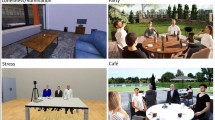Abstract
Cigarette smoking in adolescents is a major public health problem. To address the increasing need for efficacious assessment and treatment methods, we developed and tested a novel virtual reality cue reactivity assessment system. A case study of a controlled virtual reality cue reactivity trial with a 17-year-old adolescent cigarette smoker is presented. During the trial, the participant was exposed to virtual reality (VR) smoking cues and VR neutral cues and assessments of subjective craving and skin conductance response (SCR) were recorded. Upon exposure to VR smoking cues, craving increased. A novel methodology for collecting and analyzing SCR in VR was developed and explored to expand the role of physiological variables in VR research. SCR data indicated specific reactions to smoking cue stimuli, with the subject experiencing increased reactivity to smoking cues (i.e., cigarettes) compared to food or drinks. Based on this case study, further research using VR cue reactivity assessment in adolescent smokers is warranted. The impact of VR in drug research and future applications in research are also discussed.
Similar content being viewed by others
References
American Health Association. (1995, October 4). Action Alert! The Nation’s Health Official Newspaper of the American Health Association.
Bordnick, P. S., & Graap, K. (2004). Virtual reality nicotine cue reactivity assessment system (VR-NCRAS) (Version 1.0) [pc]. Decatur, GA: Virtually Better, Inc.
Bordnick, P. S., Graap, K. M., Copp, H., Brooks, J., Ferrer, M., & Logue, B. (2004). Utilization of virtual reality to standardize nicotine craving research: A pilot study. Addictive Behaviors, 29(9), 1889–1894.
Bordnick, P. S., Graap, K. M., Copp, H. L., Brooks, J., Logue, B., & Ferrer, M. (2004). Virtual Reality Cue Reactivity Controlled Trial: Nicotine. Paper presented at the American Psychiatric Association, New York.
Centers for Disease Control and Prevention. (1994). Preventing tobacco use among young people, a report of the Surgeon General. Atlanta, GA: US Department of Health and Human Services.
Colby, S. M., Tiffany, S. T., Shiffman, S., & Niaura, R. S. (2000). Are adolescents smokers dependent on nicotine? A review of the evidence. Drug and Alcohol Dependency, 59(Suppl. 1), S83–S95.
Grunbaum, J. A., Kann, L., Kinchen, S. A., Ross, J. G., Hawkins, J., Lowry, R., et al. (2004). Youth risk behavioral surveillance. Morbidity and Mortality Weekly Report (MMWR), 53(SS-2), 1–95.
Heatherton, T. F., Kozlowski, L. T., Frecker, R. C., & Fagerstrom, K. (1991). The fagerstrom test for nicotine dependence: A revision of the fagerstrom tolerance questionnaire. British Journal of Addiction, 86, 1119–1127.
Lazev, A. B., Herzog, T. A., & Brandon, T. H. (1999). Classical conditions of environmental cues to cigarette smoking. Experimental and Clinical Psychopharmacology, 7(1), 56–63.
Lee, J. H., Ku, J., Kim, K., Kim, B., Kim, I. Y., Yang, B. H., et al. (2003). Experimental application of virtual reality for nicotine craving through cue exposure. CyberPsychology and Behavior, 6(3), 275–280.
Sayette, M. A., Martin, C. S., Wertz, J. M., Shiffman, S., & Perrott, M. A. (2001). A multi-dimensional analysis of cue-elicited craving in heavy smokers and tobacco chippers. Addiction, 96(10), 1419–1432.
Stanton, W. R., Lowe, J. B., & Gillespie, A. M. (1996). Adolescents’ experiences of smoking cessation. Drug and Alcohol Dependency, 43, 63–70.
Substance Abuse and Mental Health Services Administration. (2002). Summary of findings from the 2001 national household survey on drug abuse: Volume II. (No. (SMA) 02-03759). Rockville, MD: DHHS.
Tiffany, S. T., Cox, L. S., & Elash, C. A. (2000). Effects of transdermal nicotine patches on abstinence-induced and cue-elicited craving in cigarette smokers. Journal of Consulting and Clinical Psychology, 68(2), 233–240.
Author information
Authors and Affiliations
Corresponding author
Rights and permissions
About this article
Cite this article
Bordnick, P.S., Traylor, A.C., Graap, K.M. et al. Virtual Reality Cue Reactivity Assessment: A Case Study in a Teen Smoker. Appl Psychophysiol Biofeedback 30, 187–193 (2005). https://doi.org/10.1007/s10484-005-6376-0
Issue Date:
DOI: https://doi.org/10.1007/s10484-005-6376-0




